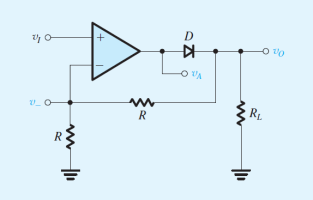logistic_guy
Senior Member
- Joined
- Apr 17, 2024
- Messages
- 2,214
The op amp in the precision rectifier circuit shown is ideal with output saturation levels of \(\displaystyle \pm 13 \ \text{V}\). Assume that when conducting the diode exhibits a constant voltage drop of \(\displaystyle 0.7 \ \text{V}\). Find \(\displaystyle v_{-}, v_O, \text{and} \ v_A\) for:
\(\displaystyle \bold{(a)} \ v_I = +1 \ \text{V}\)
\(\displaystyle \bold{(b)} \ v_I = +3 \ \text{V}\)
\(\displaystyle \bold{(c)} \ v_I = -1 \ \text{V}\)
\(\displaystyle \bold{(d)} \ v_I = -3 \ \text{V}\)
Also, find the average output voltage obtained when \(\displaystyle v_I\) is a symmetrical square wave of \(\displaystyle 1\)-\(\displaystyle \text{kHz}\) frequency, \(\displaystyle 5\)-\(\displaystyle \text{V}\) amplitude, and zero average.

\(\displaystyle \bold{(a)} \ v_I = +1 \ \text{V}\)
\(\displaystyle \bold{(b)} \ v_I = +3 \ \text{V}\)
\(\displaystyle \bold{(c)} \ v_I = -1 \ \text{V}\)
\(\displaystyle \bold{(d)} \ v_I = -3 \ \text{V}\)
Also, find the average output voltage obtained when \(\displaystyle v_I\) is a symmetrical square wave of \(\displaystyle 1\)-\(\displaystyle \text{kHz}\) frequency, \(\displaystyle 5\)-\(\displaystyle \text{V}\) amplitude, and zero average.

